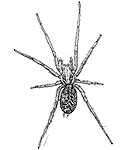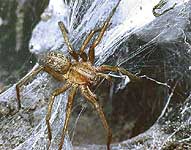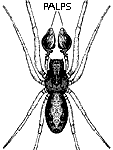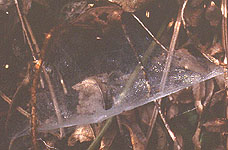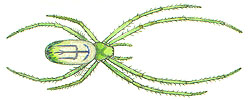 |
|
| You Are Here: Burke Museum : Spider Myths : "Dangerous" : Hobo Spider |
Myths about "Dangerous" Spiders
Myth: You can recognize the Hobo Spider by a chevron pattern on the abdomen, "boxing glove" shaped palps in front of the body, and funnel-shaped web.
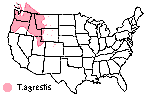 |
| Hobo spider Tegenaria agrestis Real distribution in 2002; real bites do not occur outside pink area! Small dots are isolated populations. Click image to enlarge |
Fact: This common idea is a misinterpretation
of basically correct information found on the Internet about the hobo spider,
a (possibly) medically important species of northwestern USA (see
map, right) and Europe (and nowhere else). People will insist on
finding a way (no matter how bogus) to "recognize" a spider by so-called
markings...
True, this species often has a pattern of chevrons on the abdomen, but they
are worthless in identification. That is one of the commonest pattern types
among spiders, and literally thousands of species have it. What's more, it's
not always present in hobo spiders — like other species, they are variable
in color!
Again, hobo spiders do make a funnel web, but that is a characteristic of the
entire spider family Agelenidae, with numerous species; even some non-agelenids
make funnel-like webs; so the funnel does not mean hobo spider.
And again, it's true that male hobo spiders have enlarged pedipalps. But that
doesn't mean you can recognize the species that way; every male spider
on earth has enlarged palps! Those are the male sex organs, and naturally, males
all have them. The fine structure of the palps is indeed one of the keys to
identification, but to see how a hobo spider's palp differs from other male
palps you need a microscope with at least 30x magnification.
As with most spiders, a naked-eye view is simply not enough to identify a hobo
spider. Whole body photos on web sites (including the old Hobo
Spider Web Site) are only for illustration and have no identification
value; around 200
other species in the same region appear similar.
Please note that if you live outside its range (pink area on map), you don't
have hobo spiders!
Update: It's been 24 years since my late friend Darwin Vest found severe effects on laboratory rabbits bitten by male hobo spiders. His data led everyone to assume that hobo spiders caused many apparent human "spider bite" cases. However, over the past quarter century, not one patient has come forward who (1) was initially healthy, (2) developed the "typical hobo spider bite symptoms," and (3) was able to produce any spider that had bitten him/her. Within the range of the brown recluse, genuine necrotic-bite patients recover the spider about 20% of the time, so "hobo spider victims" should have managed it at least once. On the other hand, several humans and dogs developed no significant symptoms when bitten by hobo spiders that were recovered and identified. Some such cases can be explained as "dry bites," but it seems increasingly likely that these "hobo spider bite" cases, or most of them, are not actually being caused by a spider.
Myth: Hobo spiders are aggressive.
Fact: Once upon a time, an entomologist who shall
be nameless wanted to write about the spider Tegenaria agrestis. "Agrestis"
is a Latin word meaning "rural." But this gentleman didn't know much
Latin, so he coined the name "Aggressive House Spider" for the species.
Arachnologists suspected that the name was intended to encourage irrational
fear of spiders, for reasons it is better not to speculate on. In any case,
everyone who knew anything about the species realized how inappropriate that
name was.
The species is not aggressive, except in that any predator shows aggression
toward its prey, and any spider is liable to bite when trapped against one's
skin. The species is not a true house spider; in fact, it cannot live
permanently in buildings and is the only real example of that otherwise mythical
idea that outdoor spiders wander into houses. Generally it is the males that
do this wandering, and females are seldom found indoors. And finally, "aggressive"
has nothing to do with the meaning of the scientific name.
This unacceptable, fake name was firmly rejected by both the entomological and
arachnological common-names boards, but nevertheless it's been used in a number
of publications. Evidently people would rather think that spiders are
more dangerous than they really are! "Hobo spider" (from its common
occurrence along railroad tracks and spread along transportation corridors)
is the authorized common name.
| Previous Myth | Myths Home | Web Resources | Next Myth |
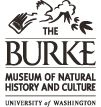 |
Text ©
2003-2010, Burke Museum of Natural History & Culture, University of Washington, Box 353010, Seattle, WA 98195, USA Phone: 206-543-5590 Photos © as credited |
Queries
to Spider Myths author, Rod Crawford This page last updated 10 September, 2010 This site best viewed at 800 x 600 using IE 5.0 or above. |
